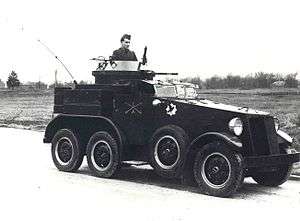M1 Armored Car
| M1 Armored Car | |
|---|---|
|
M1 armored car | |
| Type | Armored car |
| Place of origin |
|
| Production history | |
| Designer | James Cunningham |
| Number built | 12 |
| Specifications | |
| Crew | 4 |
|
| |
Main armament | M2 machine gun |
Secondary armament | 2 or 3 x .30 (7.62 mm) machine guns |
| Engine | 8-cylinder gasoline |
| Suspension | wheels, 4X6 |
Operational range | 250 miles |
| Speed | 55 MPH |
The M1 Armored Car was a four-wheel drive American armored car tested by the Ordnance Department in 1931. It was built by James Cunningham, Son and Company of Rochester, New York, and during testing demarcated as the Model T4.[1][2]
History
Two T4 were built to Ordnance specifications by Cunningham Motors, Rochester, New York. Subsequent ones were built by Rock Island Arsenal[3]
Two T4 rest vehicles were built in 1931 and tested until 1934, when they were standardized as the M1. Some sources indicate an additional ten T4s may have been built before standardization- Army records list only 12 M1 cars being accepted, though it is unclear if these are all new built vehicles or if the number includes the ones originally built as T4s. If the records refer to two different orders, the maximum number built for each type is still only twelve T4 and twelve M1. All vehicles of both designations are believed to have been issued to the First Cavalry Regiment for testing and trials. They are all believed to have been removed from service prior to 1939.
It was powered by an 8-cylinder gasoline engine, sported a crew of four and was armed with a maximum of one .50 machine gun permanently mounted in the turret and two 'backup' .30 machine guns mounted in fore and aft firing ports. The turret also had fittings for mounting one of the machine guns for anti-aircraft use, though this was never tested by the Army. It could hit a speed of 55 mph on paved surfaces, and had an estimated cruising range on roads of approximately 250 miles.
While it actually has six wheels (eight if you count the semi-usable spares behind the front axle), it is listed as a 4WD vehicle- the two rear axles are powered, while the front axle is only used for steering. This is different from many US Military combat vehicles which came later, most of which were all-wheel drive (4x4 or 6x6). Though it had respectable (for the 1930s) performance on paved and improved surfaces, the lack of powered front wheels and its length combined to give it very poor off-road performance, especially in mud and snow. The spare wheels were mounted on free-spinning 'stub axles' in an effort to keep it from bottoming out the chassis, but they did nothing to help it get unstuck.
Although the vehicle itself was not adopted for mass production, it showed enough benefits over continued use of the horse to warrant further study and experimentation at mechanizing the U.S. Cavalry through the rest of the 1930s and into the early 1940s. Lessons learned in its trials also led to the design and adoption of more successful Armored Cars, such as the T17 Staghound and M8 Greyhound. The lessons learned about its cross country performance were a factor in the eventual adoption of light tanks and half-tracks for many mechanized cavalry and recon units in the early 1940s.
See also
- List of U.S. military vehicles by supply catalog designation (SNL G-29)
- List of U.S. military vehicles by model number
References
- ↑ George F. Hofmann (3 July 2006). Through Mobility We Conquer: The Mechanization of U.S. Cavalry. University Press of Kentucky. pp. 294–. ISBN 978-0-8131-3757-5. Retrieved 11 September 2012.
- ↑ Herbert C. Banks (20 January 2003). 1st Cavalry Division: A Spur Ride Through the 20th Century from Horses to the Digital Battlefield. Turner Publishing Company. pp. 9–. ISBN 978-1-56311-785-5. Retrieved 11 September 2012.
- ↑ Icks
- Icks, Robert US Armored Cars (AFV Profile No. 40) Profile Publishing
